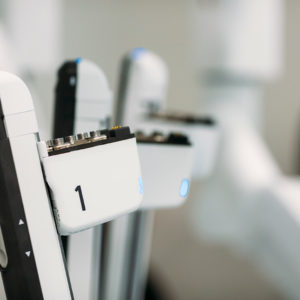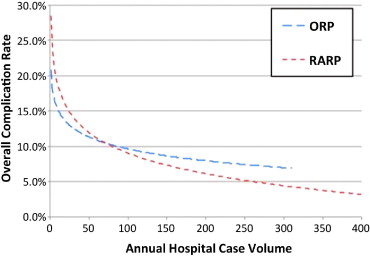
Robotic Surgery for Urological Cancers
The latest studies suggest in experienced robotic surgical units, with well-trained and experienced surgeons appropriately selected prostate cancer patients may benefit from:
- Less blood loss and lower transfusion rates;
- shorter hospital stay;
- less pain;
- earlier return of urinary continence and erectile function;
- lower risk of wound infection and scarring
- faster recovery and return to work
- Less bleeding and reduced transfusion risk.
Kidney and bladder cancer patients experience similar benefits.

Surgeons enjoy increased precision and visualisation of the procedure, with cameras inside the body providing magnification nine times greater than what the naked eye can see. The DaVinci robot has undergone many changes over the last 2 decades which is shown below with the “evolution” from the standard 3-arm model in 2000, the S and Si 4 arm models between 2008 and 2014 and now the Xi model in 2015.
Hurstville Private and St George Private are now offering robotic assisted laparoscopic surgery with the first of a new generation of surgical robots installed in NSW. The DaVinci Xi robot has distinct advantages over the current model and will expand the indications to further surgical specialties and the approach to many more Urological procedures.
Advantages
The major advantages include:
- A new overhead instrument arm architecture designed to facilitate anatomical access from virtually any position.
- A new endoscope digital architecture that creates a simpler, more compact design with improved visual definition and clarity.
- An ability to attach the endoscope to any arm, providing flexibility for visualising the surgical site.
- Smaller, thinner arms with newly designed joints that offer a greater range of motion than ever before.
- Longer instrument shafts designed to give surgeons greater operative reach
This allows the Xi robotic platform to be used by many more surgeons. For example, the technology will allow 4 quadrant surgery within the abdomen which will be very useful for general surgeons, colorectal, Upper GI surgeons and Gynaecologists.
Urologists will be able to undertake further procedures which previously were unsuitable for robotics or required open surgery including complex kidney reconstructive procedures and retro-peritoneal lymph node dissections for young men with metastatic testis cancer.
The vast majority of Robotic cases currently performed in Australia are Robotic Assisted Nerve Sparing Radical Prostatectomy for clinically localized prostate cancer.
Prostate cancer surgery is highly effective for cure but is associated with significant side effects including urinary incontinence and erectile dysfunction.
Functional results depend almost entirely on the surgical technique and approach utilised which needs to be individualised to the patient and his pathology.
Recovery of urinary continence requires meticulous preservation of the urethral sphincter complex with avoidance of bladder neck scarring which is clearly facilitated by the improved vision of the prostatic apical dissection and the more secure continuous suture reconstruction undertaken with robotics.
Recovery of potency requires meticulous, athermal, atraumatic dissection of the neurovascular bundle which is facilitated by the magnification and instrumentation provided by robotics.
The latest DaVinci Xi platform, will further refine and extend the benefits of this minimally invasive approach to a wider population of men.
Benefits
It is generally accepted that benefits of robotic assisted prostate surgery compared to open radical prostatectomy include:
- Faster recovery
- Shorter hospital stay
- Less bleeding
- Lower transfusion rate
Emerging evidence supports:
- Equivalent cancer control (no difference in positive surgical margins)
- Faster and more complete recovery of potency
- Faster return of continence
- Less bladder neck scarring/stenosis
- Fewer lymphocoeles
Is Robotic Assisted or Open Surgery for prostate cancer the best approach?
This is a very important question many patients struggle with and there is much mis-information in the literature. Open surgery has long term results and has been safe and effective over 4 decades. Robotic assisted surgery has been in common use for less than a decade with initially mixed results in early series.
Dr Cozzi has performed close to 5000 radical prostatectomies and offers both open and robotic assisted procedures with recommendations made based on clinical judgment, experience and patient and tumour factors. Our data clearly demonstrates faster time time to recovery, less pain and faster discharge from hospital.
Now with further refinement to the robotic technology by Da Vinci and further technical improvements by surgeons over recent years, results are generally superior to open surgery.
There are advantages and disadvantages to each approach.
For example, vision is enhanced by the robotic approach but there is no tactile feedback, meaning the surgeon cannot feel the tissues to decide on the degree of nerve sparing to ensure complete removal of the tumour.
With open surgery, the surgeon can feel areas he or she may be concerned about to optimise the chances of cure. However, on occasion visualisation of the surgical field can be sub-optimal with open surgery. Tactile feedback is less important to the experienced robotic surgeon who is aware that meticulous and careful surgery will not damage vital structures for recovery of potency and continence.
Furthermore with improvements in staging the cancer, surgeons can be more certain of cure and optimize robotic surgery by careful pre-operative planning. Certain patients may be more suitable to one or other approach due to patient specific factors- previous abdominal surgery or hernia repair is a good example.
Education & Qualifications
Dr Cozzi maintains his skills for both OPEN and ROBOTIC ASSISTED surgery to optimise outcomes, as patients can sometimes be unsuitable for one approach or the other.
In contrast to many recently graduated surgeons (many of whom can only perform robotic surgery), Dr Cozzi can safely and competently complete the surgery via an open approach should the robot approach fail or need to be abandoned. To date, in more than 600 cases, Dr Cozzi has not had to convert any robotic cases to open fortunately.
We will advise and make recommendations, based on our extensive experience, if patients are more suitable for one approach over the other.
Dr Cozzi trained extensively in the USA at Vanderbilt University in Nashville with Dr J Smith and in Sunnyvale, California in robotic surgery. He completed 2 years of training in cancer surgery at Memorial Sloan Kettering Cancer Centre in New York City. His mentoring and training of other robotic surgeons and our nursing team has been very favourably reviewed and internationally validated.
Dr Cozzi’s cancer control rates and functional results (recovery of potency and continence) are now well established with robotic surgery and are superior to the results of open surgery.
There are several very exciting refinements to the Da Vinci Robotic Surgery platform including the Xi Platform, which we believe will improve the results further.
As an example we have improved technology which allows nerve sparing surgery with minimal thermal or heat energy allowing the nerve fibres to remain undamaged and therefore recovery of erections much more likely to occur. The use of a haemostatic agent, Glubran 2, has lead to improved results with no bleeding and no transfusions since its implementation.
Many studies have clearly demonstrated increasing institutional and surgeon volume improves outcomes for cancer control and functional outcomes (recovery of continence and potency). A recent study showed that more than 75 cases per annum performed in a particular hospital was associated with reduced complication rates for robotic but not open surgery.

Dr Cozzi performs approximately 150-200 prostatectomies each year with about 80% performed robotically.
Dr Cozzi works extensively with allied health professionals including pelvic floor physiotherapists and sexual health experts throughout Sydney to offer patients from all locations access to pre-operative and post-operative programs to optimize recovery of continence and potency.
Dr Cozzi and his team of nurses, physiotherapists and sexual health physicians are committed to providing the best technique in the best inpatient and outpatient environment with thorough and comprehensive rehabilitation, to obtain the best results possible.
Dr Cozzi’s results are independently verified by questionnaire and by allied health professionals (physiotherapists).
Our team will discuss various approaches with you and help you decide.


